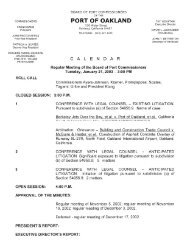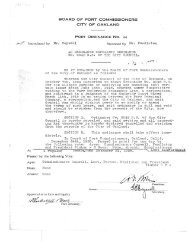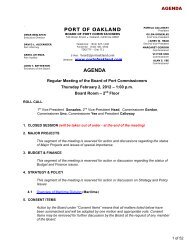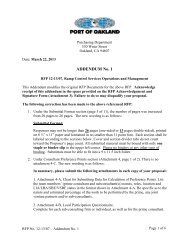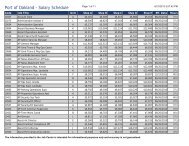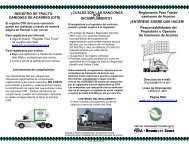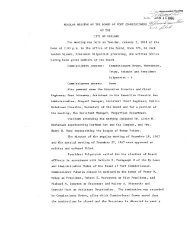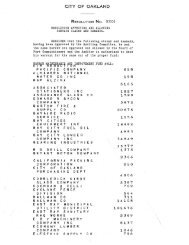Port-Wide Sewer System Management Plan(SSMP) - Port of Oakland
Port-Wide Sewer System Management Plan(SSMP) - Port of Oakland
Port-Wide Sewer System Management Plan(SSMP) - Port of Oakland
Create successful ePaper yourself
Turn your PDF publications into a flip-book with our unique Google optimized e-Paper software.
accordance with program standards. If FSFs are not in compliance with the terms <strong>of</strong><br />
their WDP, accelerated interceptor maintenance schedules or interceptor installations<br />
may then be required as necessary to mitigate the issue.<br />
Table 8.2 Best <strong>Management</strong> Practices for Fats, Oil, and Grease<br />
FOG Control <strong>Plan</strong><br />
<strong>Port</strong> <strong>of</strong> <strong>Oakland</strong><br />
BMP Reason For BMP Benefits <strong>of</strong> BMP<br />
Train all staff on BMPs. People are more willing to<br />
support an effort if they<br />
understand its basis.<br />
Post “No Grease” signs above<br />
sinks and on the front <strong>of</strong><br />
dishwashers.<br />
Check grease interceptor solids<br />
depth routinely. The combined<br />
thickness <strong>of</strong> the floating grease<br />
and the bottom solids should be<br />
not more than 25 percent <strong>of</strong> the<br />
total interceptor depth.<br />
Collect and recycle waste<br />
cooking oil.<br />
“Dry wipe” pots, pans, and<br />
kitchen equipment before<br />
cleaning.<br />
Maintain a routine grease trap<br />
cleaning schedule.<br />
Use absorbent paper under fryer<br />
baskets.<br />
Use absorbents such as cat litter<br />
or paper towels to pick up oil and<br />
grease spills before mopping.<br />
Signs serve as a constant<br />
reminder for staff working in<br />
kitchens.<br />
Grease interceptor will not meet<br />
performance standards when<br />
solids and floating grease levels<br />
exceed 25 percent.<br />
These actions reduce grease<br />
loading on grease removal<br />
devices and the sewer.<br />
“Dry wiping” will reduce the<br />
grease loading on grease<br />
removal devices and the sewer.<br />
If grease traps are not routinely<br />
cleaned, they do not work<br />
properly and do not prevent<br />
grease from entering the sewer.<br />
If a grease trap is not providing<br />
adequate protection, a grease<br />
interceptor may be required.<br />
This reduces the amount <strong>of</strong><br />
grease during clean up.<br />
Decreases the amount <strong>of</strong> grease<br />
that will be put down the drain.<br />
Trained staff will be more likely to<br />
implement BMPs and work to<br />
reduce grease discharges to the<br />
sewer.<br />
Reminders help minimize grease<br />
discharge to the sewer or grease<br />
removal device.<br />
This will keep grease interceptor<br />
working at peak performance.<br />
This will reduce the frequency<br />
and maintenance costs for<br />
grease removal devices and<br />
reduce the amount <strong>of</strong> grease<br />
entering the drain.<br />
This will reduce the frequency<br />
and maintenance costs for<br />
grease removal devices and<br />
reduce the amount <strong>of</strong> grease<br />
entering the drain.<br />
This reduces the amount <strong>of</strong><br />
grease entering the drain and<br />
protects sewers from grease<br />
blockages and overflows.<br />
This reduces the amount <strong>of</strong><br />
grease entering the drain and<br />
protects sewers from grease<br />
blockages and overflows.<br />
This reduces the amount <strong>of</strong><br />
grease entering the drain and<br />
protects sewers from grease<br />
blockages and overflows.<br />
May 2010 8-6<br />
pw://Carollo/Documents/Client/CA/<strong>Port</strong> <strong>of</strong> <strong>Oakland</strong>/8239A00/Deliverables/Ch08 (FinalA)



